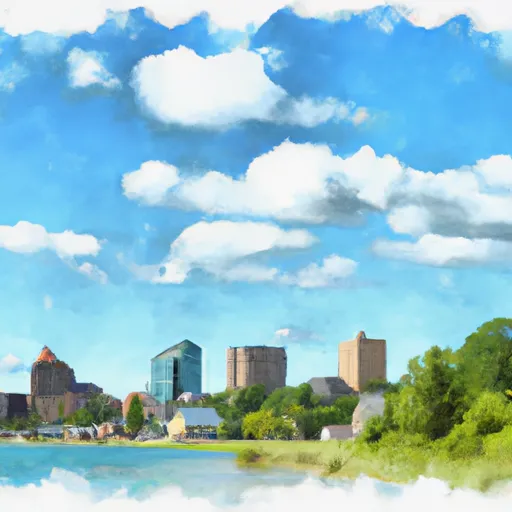-
 Snoflo Premium
Snoflo Premium
Get unlimited access to all our content
With no Ad interruptions! - Start Your Free Trial Login with existing account
Lakeside
Eden Index
Climate
7.9
•
Recreation
4.1
•
Community
•
Safeguard
4.6/10

Lakeside, Michigan is a picturesque town located along the shores of Lake Michigan. It experiences a moderate continental climate with four distinct seasons. Summers are warm with temperatures averaging in the mid-70s to low 80s Fahrenheit, while winters can be cold with average temperatures ranging from the 20s to 30s Fahrenheit. Spring and fall bring mild temperatures, making them ideal seasons for outdoor activities.
As the name suggests, Lakeside is known for its proximity to Lake Michigan, offering numerous outdoor recreation opportunities. The lake provides opportunities for swimming, boating, fishing, and water sports like kayaking and paddleboarding. The town is also surrounded by lush forests and parks, offering hiking and biking trails, camping spots, and wildlife watching. Additionally, Lakeside is home to several golf courses, making it a popular destination for golf enthusiasts.
Hydrologically, Lakeside benefits from being located near Lake Michigan, contributing to a unique ecosystem and diverse wildlife. The lake's water quality is carefully monitored to ensure it remains pristine, providing a habitat for various fish species and supporting a healthy aquatic environment.
In summary, Lakeside, Michigan offers a moderate climate, stunning natural landscapes, and a wide range of outdoor activities, making it an ideal destination for nature lovers and outdoor enthusiasts.
What is the Eden Index?
The Snoflo Eden Index serves as a comprehensive rating system for regions, evaluating their desirability through a holistic assessment of climate health, outdoor recreation opportunities, and natural disaster risk, acknowledging the profound impact of these factors on livability and well-being.
Climate Health Indicator (CHI): 7.9
Lakeside receives approximately
946mm of rain per year,
with humidity levels near 82%
and air temperatures averaging around
10°C.
Lakeside has a plant hardyness factor of
6, meaning
plants and agriculture in this region thrive during a short period during spring and early summer. Most
plants will die off during the colder winter months.
By considering the ideal temperature range, reliable water supplies, clean air, and stable seasonal rain or snowpacks, the Climate Health Indicator (CHI) underscores the significance of a healthy climate as the foundation for quality living.
A healthy climate is paramount for ensuring a high quality of life and livability in a region, fostering both physical well-being and environmental harmony. This can be characterized by ideal temperatures, reliable access to water supplies, clean air, and consistent seasonal rain or snowpacks.
Weather Forecast
Streamflow Conditions
Southwestern Lake Michigan
Area Rivers
Southwestern Lake Michigan
Snowpack Depths
Southwestern Lake Michigan
Reservoir Storage Capacity
Southwestern Lake Michigan
Groundwater Levels
Recreational Opportunity Index (ROI): 4.1
The Recreational Opportunity Index (ROI) recognizes the value of outdoor recreational options, such as parks, hiking trails, camping sites, and fishing spots, while acknowledging that climate plays a pivotal role in ensuring the comfort and consistency of these experiences.
Access to outdoor recreational opportunities, encompassing activities such as parks, hiking, camping, and fishing, is crucial for overall well-being, and the climate plays a pivotal role in enabling and enhancing these experiences, ensuring that individuals can engage in nature-based activities comfortably and consistently.
Camping Areas
| Campground | Campsites | Reservations | Toilets | Showers | Elevation |
|---|---|---|---|---|---|
| Springs Valley Rec Area | 10 | 672 ft | |||
| Celina Recreation Area | 55 | 709 ft | |||
| Tipsaw | 50 | 576 ft | |||
| Dubois County Park | 32 | 575 ft | |||
| Newton Stewart State Rec Area - Patoka Lake | 500 | 728 ft | |||
| Ferdinand State Forest | 70 | 489 ft | |||
| Crane MWR Military | None | 594 ft | |||
| Owen Putnam State Forest | 35 | 597 ft | |||
| Martin State Forest | 25 | 743 ft | |||
| Sycamore Springs Park | None | 490 ft |
Nearby Ski Areas
Catastrophe Safeguard Index (CSI):
The Catastrophe Safeguard Index (CSI) recognizes that natural disaster risk, encompassing floods, fires, hurricanes, and tornadoes, can drastically affect safety and the overall appeal of an area.
The level of natural disaster risk in a region significantly affects safety and the overall livability, with climate change amplifying these risks by potentially increasing the frequency and intensity of events like floods, fires, hurricanes, and tornadoes, thereby posing substantial challenges to community resilience and well-being.
Community Resilience Indicator (CRI):
The Community Resilience Indicator (CRI) recognizes that education, healthcare, and socioeconomics are crucial to the well-being of a region. The CRI acknowledges the profound impact of these elements on residents' overall quality of life. By evaluating educational resources, healthcare accessibility, and economic inclusivity, the index captures the essential aspects that contribute to a thriving community, fostering resident satisfaction, equity, and social cohesion.

